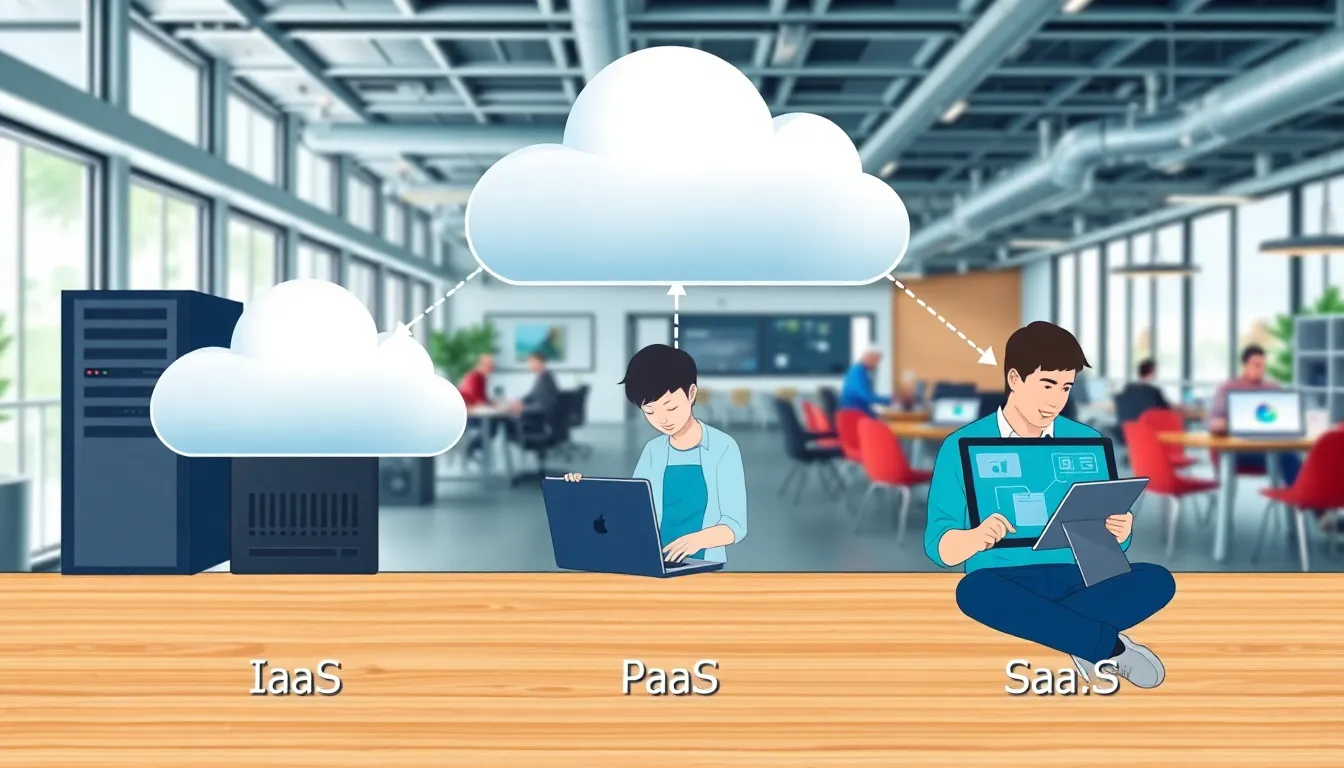In the ever-evolving world of technology, businesses are faced with a critical choice: to build their IT infrastructure from scratch or to embrace the cloud. Enter IaaS, PaaS, and SaaS—the trio of cloud computing that’s transforming how companies operate. It’s like having a buffet of services where you can pick exactly what you need without the calories of managing everything yourself.
Imagine IaaS as your reliable handyman, providing the bare bones of infrastructure. PaaS steps in like a sous-chef, giving developers the tools to whip up applications with ease. And then there’s SaaS, the ultimate takeout option, serving ready-to-use software that lets you focus on what really matters—growing your business. With these models, the cloud isn’t just a trend; it’s a game-changer. Ready to dive into the cloud and find out which service suits your needs best?
Table of Contents
ToggleOverview of IaaS, PaaS, and SaaS
Cloud computing encompasses three primary service models: IaaS, PaaS, and SaaS. Each model offers unique capabilities to cater to varying business needs.
Definition of IaaS
IaaS stands for Infrastructure as a Service. This cloud model provides virtualized computing resources over the internet. Businesses gain access to crucial infrastructure elements like servers, storage, and networking without the need for physical hardware. This on-demand service model allows companies to manage their IT resources flexibly. Users pay for what they utilize, enabling cost efficiency. Providers such as Amazon Web Services and Microsoft Azure play significant roles in delivering IaaS solutions.
Definition of PaaS
PaaS, or Platform as a Service, offers a development framework for applications without the complexities of managing underlying infrastructure. Developers can focus on writing code and deploying apps instead of worrying about hardware and software maintenance. This service includes tools for database management, application hosting, and integration. PaaS solutions facilitate faster development cycles and enhance collaboration among team members. Notable providers include Google App Engine and Heroku.
Definition of SaaS
SaaS, which means Software as a Service, delivers ready-to-use software applications over the internet. Users access these applications via web browsers, eliminating the hassles of installation and maintenance. Since providers manage everything from infrastructure to updates, businesses can focus on their core operations. A subscription model typically governs SaaS, ensuring predictable costs for companies. Popular examples include Salesforce, Dropbox, and Microsoft 365, each streamlining business processes effectively.
Key Differences Between IaaS, PaaS, and SaaS

Understanding the key differences among IaaS, PaaS, and SaaS provides clarity for businesses deciding on cloud services. Each model offers distinct features tailored to specific needs.
Level of Control
IaaS provides the highest level of control, enabling businesses to manage servers, storage, and networking directly. Users configure the infrastructure as required. In contrast, PaaS offers less control, focusing on application development without needing to manage underlying hardware. Developers use available frameworks and tools for coding and deployment. SaaS delivers the least control, providing complete software applications managed by vendors. Users access features without dealing with infrastructure or application maintenance.
Use Cases and Examples
IaaS is ideal for companies requiring flexible IT resources, such as startups that need to scale quickly. Amazon Web Services and Microsoft Azure are common examples. PaaS suits organizations focused on rapid application development, like tech companies using Google App Engine or Heroku to streamline processes. SaaS serves businesses seeking ready-to-use solutions, with examples like Salesforce and Microsoft 365, allowing teams to manage tasks efficiently without installation or updates. Each model has unique advantages based on business goals.
Advantages of IaaS, PaaS, and SaaS
Businesses benefit significantly from adopting IaaS, PaaS, and SaaS models due to their unique advantages. Each model supports various operational needs while enhancing overall efficiency.
Cost Savings
IaaS, PaaS, and SaaS contribute to substantial cost savings. IaaS eliminates the need for heavy upfront investments in physical hardware, allowing businesses to pay only for the resources used. PaaS reduces development costs by providing pre-built tools and environments, minimizing the need for extensive coding or infrastructure setups. SaaS offers predictable subscription pricing, eliminating unexpected expenses associated with traditional software installations. These models enable businesses to maintain tighter budget controls while accessing necessary technologies and services.
Scalability and Flexibility
Scalability defines the value of IaaS, PaaS, and SaaS models. IaaS allows organizations to quickly scale resources up or down based on demand, ensuring they pay only for what they use. PaaS provides flexibility in development, as it offers various tools and frameworks that adapt to changing project requirements. SaaS applications often include options for scaling user access, enabling businesses to accommodate growth without extensive system changes. Each model ensures organizations can confidently adjust their resources to meet evolving demands, ultimately enhancing operational agility.
Choosing the Right Model for Your Business
Selecting the appropriate cloud model significantly impacts a business’s efficiency and growth. Each option—Infrastructure as a Service (IaaS), Platform as a Service (PaaS), and Software as a Service (SaaS)—has unique strengths tailored to diverse organizational needs.
Considerations for IaaS
IaaS provides flexibility for businesses requiring custom solutions. Companies can manage servers, storage, and networking without substantial upfront investments. High levels of control allow IT teams to tailor infrastructure to specific applications or workloads. The pay-as-you-go pricing model also supports cost-effectiveness, aligning expenses with actual usage. Businesses needing scalability can quickly adjust resources based on fluctuating demands, ensuring optimal performance.
Considerations for PaaS
PaaS streamlines application development, focusing on coding while abstracting infrastructure management. Development teams benefit from collaborative tools and pre-built environments. This model minimizes deployment time, promoting quicker project turnaround. Companies emphasizing innovation may find PaaS ideal for building and scaling applications without managing underlying resources. Cost savings stem from utilizing pre-existing frameworks, allowing teams to concentrate on developing unique features.
Considerations for SaaS
SaaS facilitates immediate access to fully functional software applications via the internet. Businesses benefit from vendor management, eliminating the burden of software upkeep and updates. Predictable subscription costs aid in budget planning, enhancing financial control. Organizations prioritizing ease of use and quick implementation often prefer SaaS solutions. Scalability allows companies to adjust user access seamlessly based on needs, ensuring software solutions grow with the business.
Choosing between IaaS, PaaS, and SaaS can significantly impact a business’s IT strategy. Each model offers distinct advantages tailored to different operational needs. IaaS provides flexibility and control for those seeking customized infrastructure solutions. PaaS fosters innovation and accelerates application development, making it ideal for tech-driven environments. Meanwhile, SaaS delivers convenience with ready-to-use applications, allowing businesses to focus on core functions without the hassle of management.
By understanding the unique strengths of each model, organizations can make informed decisions that align with their goals. Embracing the right cloud service can lead to enhanced efficiency, cost savings, and scalability, ultimately driving growth in today’s competitive landscape.






